#advantages of react over angular
Link
React JS is a popular JavaScript library used for building user interfaces for web applications. Its popularity has skyrocketed in recent years due to its ability to deliver high-performing, fast, and interactive applications. React JS is a great choice for web development, and in this guest post, we will discuss its top features and benefits.
#web development#advantages and disadvantages of react js#advantages of reactjs#why react js#advantages of react over angular#disadvantages of react over angular#features of react js#why we use react js instead of javascript#what is react js
1 note
·
View note
Link
Every framework has its strengths and weaknesses. But, React JS Framework provides several advantages over other JavaScript frameworks.
0 notes
Text
Lilith square Ascendant

Lilith square ascendant is an interesting placement. It’s packed with energy that often seems excessive and uncontrollable. Lilith energy is always tied to the mythology of Adam’s first wife, Lilith. She was an unfit wife because she saw herself as equal to Adam and could not be “tamed” to follow him as her husband. Lilith the figure is filled to the brim with complexity, s*xual energy, and intrigue just like the placement is.

Lilith can be felt powerfully in the angular houses (1st, 4th, 7th, 10th) as these are the houses tied to how you are perceived and received by others (self, childhood/family, spouse/partners, public). Personally I have Lilith in my 10th house squaring my ascendant which is why I wanted to dive into some of my observations with this placement.
Lilith aspecting the ascendant is often observed as an alluring placement. Lilith is impactful, often others will have a strong reaction to you. When you walk into a room you will have people that immediately love or hate you no matter how neutral you attempt to be.
Individuals with Ascendants that are Trine/Sextile to Lilith tend to enjoy and find empowerment from the often sexual attention they receive. While Asc Conjunct/Square/Opposition Lilith individuals tend to feel disgusted or turned off by these strong reactions.
In all honesty, strong Lilith placements are in the individual’s birth chart to encourage them to come into their own without shame or making themselves smaller for others.

Lilith square ascendant is said to be the most alluring and untamable placement because of the strength of the tension of energy of this aspect.
In addition to that, there’s something startling about the energy of strong Lilith placements/aspects, not because of Lilith herself but because of the reactions of others.
People often assume that the version they perceive of you to be all that you are. They also tend to be quite possessive and controlling of you. Either they shame and avoid you because they feel especially overwhelmed by your energy. Or they try to capture you, as if they could be the one to assert total control and dominance over you and to make you up in whatever image they view as “respectably feminine”.
This is obviously a trap, because Lilith’s energy cannot be muted, so when controlling people cannot change your essence they will sometimes react badly. As if they are following dark impulses, something snaps and they simply cannot process you being so uncontrollable.

Personally with my Lilith in 10th house in Leo squaring my ascendant in Scorpio, I find I usually get a certain set of reactions. From feminine energies, I often get femmes that suddenly get very competitive with me. For attention, skill, or otherwise, especially at work. (Check your 11th house to see where competition tends to come up). I usually have an easier time making friends with femmes with Lilith energies who are more aware of and embrace their “alternative” or “dark feminine” sense of expression and social s*xual power/identities.
For masculine energies I often get contempt or infatuation. Contempt in the form of avoidance and belittling. Or infatuation in the form of pushing boundaries with leery behavior. Something about Lilith makes some men really uncouth in a jarring way. It’s like the socially polite part of their brain just shuts down and they devolve in front of you.
Lilith isn’t a bad placement, just to be clear. I don’t believe any placement is bad, I know that every placement has its disadvantages and advantages and your lesson is to use them accordingly. Lilith is just a litmus test. If someone is an envious, possessive, abrasive sort of person, their behavior will be shown to you almost immediately. Especially with very masculine or very “traditionally” feminine energies.

I’m synastry too, Lilith overlays will show you a lot about your partner and their behavior towards you. Lilith shows if people around you are developed or undeveloped the easiest of most placements I believe.
This is definitely a placement to be careful with because you can’t really tell how far into scary behavior other people will go once they’ve made up their minds about you.
Day by day, I’m learning Lilith’s lesson of not letting people control you by gaining means to be independent and have my autonomy supported throughout my relationships always, but I’ve definitely gotten through some scary situations by having to get away from people that want me to submit to them.

#astro observations#astroblr#astro community#leo#scorpio#lilith square ascendant#lilith#lilith aspects#black moon lilith#astro notes
559 notes
·
View notes
Text
Character Analysis: Levi Ackerman "Humanity's Strongest Soldier

Levi Ackerman リヴァイ・アッカーマン --- "Humanity's Strongest Soldier" 人類最強の兵士 --- Levi Heichou
“I want to put an end to that recurring nightmare, right now. There are those who would get in my way. But I'm fine playing the role of the lunatic who kills people like that. I have to be ready to rearrange some faces. Because I choose the hell of humans killing each other over the hell of being eaten.”
Introduction:
I think Levi's popularity kind of clouded a lot of people's opinions on him; they didn't see him as anything deeper than a badass scout. With all that being said, Levi is definitely one of the best developed characters with a great backstory and complexity.
────────────────────────────────────────
i. design:
Levi has a surprisingly young visage, narrow, intimidating dull gray eyes with dark circles under them, and short, straight black hair styled in an undercut curtain. Despite his short stature, the intensive use of vertical maneuvering equipment has given him a well-developed muscular frame. He usually has a frown on his face or displays no emotion at all, which makes it challenging for people to predict what he is thinking.
Levi has a visage that is thin and sleek, with thin eyebrows, angular eyes, a pointed nose, and a narrow jawline. Additionally, he appears younger due to his plum-shaped face, pointed bottom, and short lower portion of the crown. Except for his tail, his eyes are peacefully down, giving him a generally lazy appearance.
ii. fighting prowess:

The Ackermans have special abilities beyond most people. Their ancestors were granted enhanced strength, dexterity, and response time as a result of experiments in order to defend the King. The phrase "knowing what has to be done" used by Levi to describe the skill may allude to a slight foreknowledge of the opponent's movements that allows the user to react before the opponent even initiates a move. They are also aware of every battle their forefathers have participated in subconsciously. They were also immune to the King erasing the memories of the world before the Walls from the population, and thus hunted down and killed.
Levi is said to have strength equal to that of an entire battalion. He is incredibly strong both mentally and physically, and he has boundless endurance. He has proven to be an unmatched fighter, taking down some of the strongest characters in the series, including the infamous Beast Titan battles, in which he consistently and apparently effortlessly dispatched the beast. He demonstrates proficiency with the ODM gear and the blades he uses, and his cool, collected demeanor makes him the most dependable and effective member of the Survey Corps. Even after losing several of his fingers, Levi was still able to utilize the equipment almost as easily as before. He is also an extremely emotional person and is driven by his need to protect those around him and hides this behind his cold demeanor. Thes protective nature gives him strength in battle along with his Ackerman strength.


Levi can fight alone without using the normal tactics that soldiers would use to draw the giant's attention and sever its neck, such as surprise attacks or mass gatherings. He kills a Titan by spinning his body quickly around like a top while fighting, but only Levi employs this style of movement in the narrative. The ignorant Titans demonstrate a different degree of strength, decimating dozens of them like ants in a field and crushing their opponents in a fight with nine much more powerful Titans.
He has demonstrated the ability to disable the Female Titan by moving too quickly for her to protect him, something that entire squads and even Eren in his Titan form were unable to do. Zeke Yeager, one of the most powerful Warriors in the Marley force and a highly skilled Titan, was even defeated by him in his Beast Titan form. Both of these attacks had some level of planning and situational advantage because the Female Titan was exhausted from multiple battles in a short period of time and Levi surprised Zeke by engaging him and approaching too closely for Zeke to protect against. Despite this, Levi still possesses incredible skill with a pair of blades and was able to quickly carve the Beast Titan's arm into several clean pieces that all dropped to the ground together. However, Levi has demonstrated that he is capable of facing off against strong Titans in a one-on-one battle where he can make the most of his vertical moving abilities. For instance, Levi once again defeated Zeke in a woodland setting where he could effectively use his vertical equipment.
His anti-personnel combat ability was also impressive, as evidenced by the fact that he was battling Kenny while carrying an anti-personnel mobile device against the Central Military Police. He quickly dispatched 12 people despite the unfavorable circumstances of the surprise and harm suffered by the Central Military Police, commanded by Kenny Ackerman. He shoots the three-dimensional anchor to pierce the neck of a military police officer on the roof, and after seeing Kenny's reflection in a bottle, the officer fires back. Avoiding bullets is a fundamental skill. Levi was unable to be apprehended despite the fact that the surprise assault was flawless and well-planned, and the number of military police casualties reached double digits.

Because his comrades drank Zeke’s spinal fluid, they turned into Titans and attacked Levi, who ultimately had to kill them. It was a tough thing for him to do (both mentally and physically), but he was able to succeed. It was one of the most tragic yet spectacular fights of Levi.

Levi has demonstrated a profound ability to quickly assess situations and make thoughtful decisions even in the heat of battle, in addition to his exceptional battle skill. This has enabled him to save himself and his allies on numerous occasions, such as when he realizes the Female Titan cannot be easily killed due to her skin hardening and regenerative abilities, saving Mikasa in the process, or the time he battles Kenny Ackerman inside a bar, stopping his enemies with chairs, a double-barreled shotgun, and even corpses. Levi acknowledges that not everyone can be correct all the time and that some situations are out of a person's control.
iii. trauma:
Levi was malnourished, on the brink of death, and by himself in a filthy brothel underground with his prostitute mother. Despite her financial difficulties as a single mother, Kuchel obviously cared for her son and did everything she could to provide for him. Despite her best efforts, hunger remained a continuous companion, and grime and dirt were unavoidable due in large part to living beneath a metropolis.
He painstakingly observed his mother's illness-related demise. The sadness of Levi's early life is punctuated by his inability to leave her room, whether due to a wish to die with her or a dependency that left him with no other choices. He was later raised in the underground city by his psychotic uncle Kenny Ackerman (whom he was unaware of at the time). From an early age, he had to adapt to the cruelty of the world, which is the central theme of Attack on Titan. He was involved in fights, so in essence, he learned to survive. But ultimately, while Levi was still a child, Kenny left him behind.


He developed a reputation as a notorious thug in the underground city and amassed a small group of followers. Erwin welcomed him and his group into the survey corps and granted them permission to live on the surface for a variety of reasons. However, he lost his entire squad, who to him was like a family, while battling the titans. Only two of his childhood friends, who he witnesses dying, have he ever developed a connection with; consequently, his affection transforms into sadness, which in turn leads to rage, which in turn leads to hatred, which in turn leads to retaliation.
After the cataclysmic failure of the 57th Expedition, Levi was approached by Petra's father. He had received a letter from Petra, a competent and devoted soldier who was a member of Squad Levi, in which she expressed her devotion to Levi. Levi was only able to stare ahead as the man, who was unaware that his daughter had died, made a joke about Petra being too young to get married and that she should wait until she has more life experience to make such a significant choice.
His two childhood friends, his uncle Kenny, and his subordinates from the Special Operations Unit of the Survey Corps, Erwin Smith and Hange Zoe passed away in battles, leaving Levi alone. It was a tragic and bitter device that demonstrated that no matter how powerful a person's combat ability, they are powerless against the cruelty and irrationality of the outside world. Levi isn't flawless; he struggles and exhibits some social awkwardness. Although his past experiences helped mold him into the person he is today, the tale did not exaggerate this fact, which gave him a much more well-rounded personality because too pretentious backstories frequently result in over-glamorizing characters.
iv. tendency to violence:

He has a severe obsession with maintaining both his personal and physical cleanliness. He doesn't like to be handled for fear of becoming dirty. I think that he may have acquired this trait as a result of his parenting. He is severely traumatized and twisted, sleeps in a chair, and only sleeps briefly, so it's conceivable that he experiences terrifying nightmares.Given that mental health care is probably non-existent in the AOT world and that watching literally everyone you care about die in horrifying ways as a child has to mess with your mental health, the chances of someone like Levi developing mental or emotional illness are extremely high.
He is violent and bad mouthed because he was raised by a violent serial killer. In the course of his missions, Levi has killed over 200 Titans, and each time he was hailed as a hero by the unsuspecting crowd, while most of his comrades were slaughtered or killed, and he felt the weight of that, because he understands the value of human life.


The peculiar way he handles his cup is another oddity that intrigues me greatly. Even his weapon is held in the wrong hand. He does have a penchant for using force to enforce his will; he beat Eren to prove to the judge that he has control over him. He treated Historia harshly in the manga when he was attempting to "persuade" her to become monarch. (this scene was totally different in the anime). He has made some terrible choices, such as abandoning Isabel and Farlan so he could go and kill Erwin, which almost certainly resulted in their deaths. Had he remained with them, they would have been more likely to survive. When the Survey Corp had Annie restrained in the forest, taunting her about having her limbs severed probably frightened her, causing her to summon the mindless titans and flee. After Annie had slain every member of Levi's team, Eren was left alone and exposed to capture.


v. humanity:
Now despite how he is, Levi might be the nicest, most softhearted character in the series.
On the 56th Expedition Beyond the Walls, Levi saw a soldier caught in the jaws of a nearby Titan and killed it. Levi gave Petra the directive to care for the hurt soldier while he dealt with the lingering Titans as more of them drew near. Levi checked on the wounded soldier after the local area had been cleared, but he had already passed away from his wounds. In his final moments, Levi tried to console the scout by telling him he had done his job well and that he would kill all the Titans.
When Levi lost his whole squad and was sitting in the room with a very depressed Eren, he tried to make a joke (no matter how un-funny) to cheer him up.

When Eren got a nosebleed after his Titan experiments, no one but Levi offered him a handkerchief and told Hange to cut down on the experiments.

One day, while having tea with Levi Squad, Eren leaned over to pick up a spoon and accidentally generated a partial Titan body. The alarmed Squad threatened him, while Levi told them to calm down.


He was reluctant to pursue Mikasa to rescue Eren, who may or may not be alive, when he lost his entire squad and discovered her fighting to save him, but after learning that Eren was a "precious friend" to Mikasa, he took the initiative and saved him. He kept Petra's insignia as a memento after she passed away. However, when another soldier broke down in tears over the loss of his comrade, he handed him Petra's badge and informed him that it belonged to his comrade.
After retreating, the Survey Corps entered Karanes and was met with hostility from the populace due to their failed objective. Petra's father confronted Levi and told him how often she wrote to him. He admitted to Levi that he was concerned about Petra's choice to devote her life to him as a parent because she was still quite young and had her entire life ahead of her. Still troubled by what had happened, Levi walked quietly on without saying anything.
When Erwin died and he had a last chance to save either him or Armin, even though his heart must have hurt he still chose to save Armin. Because he had heard Armin talk about his dreams of seeing the ocean. And maybe that reminded him of his own friends and how they used to dream together like this.


After Hange presented a believable hypothesis that titans are made from humans, Levi was visibly shaken. He bemoaned the fact that, while he thought he was saving humans, he was actually killing them.
After Historia's coronation, Levi was confronted by the new queen and the members of the Special Operations Squad. She punched him lightly, as Dimo Reeves had told her to do, and she dared him to retaliate. Instead of getting angry however, he smiled and thanked his friends (which shocked everyone).


When Kenny Ackerman died, he revealed that he was his uncle. Levi lost the last of his family. But even so, he continued to move forward, without telling anyone. Levi never held anyone accountable for his failures. He didn't scream that he would exact vengeance on his enemies like Eren did. Levi continued to battle for humanity in silence, using only his own strength while bearing all of his suffering. He has a lot of painful memories that keep him awake at night, but they also give him fortitude, so he is always prepared to act when disaster hits.
vi. nihilism:
Levi made the decision to destroy his enemy, the Titans, as soon as his friends perished, but despite the fact that he adopted a completely different strategy than Eren did in the first three seasons, Levi was basically a nihilist, at least in part.
But he doesn't do this because he hates Erwin; rather, he simply doesn't see value in the human dream, which in theory should be what motivates people to get out of bed in the morning. He doesn't see value in human existence to the point where he has no problem telling his friend Erwin to die and not give a damn about his dream.
In contrast to Erwin, who wants to triumph in order to realize his dream of learning the truth about the world, Levi rejected this idea if it was not necessary for victory. Levi's objective is to destroy the enemy. Since Zeke, who ironically wants to kill, shares Levi's nihilism and believes that death is a form of liberation from the world's cruelty, Levi chooses to save Erwin over Armin because Erwin is his close friend and thus deserves to be freed from the hell of this cruel world.
The Survey Corps began a large-scale mission to retake Wall Maria from the titans who had conquered it years earlier under the direction of Erwin Smith. The soldiers are shocked to discover that there are no titans in the city, but Zeke Yeager has created a trap for them. Erwin's resolve briefly wavers as he longs to survive and discover the mysteries of Grisha Yeager's cellar as he is cornered in the city by the Colossal Titan and the Armored Titan and is being shelled by the Beast Titan's artillery. Levi gives Erwin the command to abandon his goals and make a suicide attack on the Beast Titan despite the fact that he values his life. Levi makes a vow to slay the Beast Titan in order to give meaning to Erwin's death and their coworkers' deaths.
There is a fantastic dualism between Levi and his uncle Kenny.
Despite the fact that both Ackerman are renowned for their power, they couldn't be more dissimilar: The contrast between Levi and Kenny is one of an aimless man and a man with a path to follow. Kenny is a complete opportunist, has no real goals in life, and is loyal to no one but himself. He goes from being known as "Kenny the Ripper" because he had killed over 100 gendarmes to working for the gendarmerie itself. But during Kenny's concluding monologue, which I think is fantastic, this dualism gains depth.
Kenny elaborates on his theory of human nature, contending that every person succeeds in life precisely because he becomes "drunk" on something—whether it be money, women, power, or freedom—in other words, everyone advances because they have a dream. But Levi, as already mentioned, places little value on the idea of having a dream; he is an existentialist who simply moves forward; and, truthfully, these two worldviews are mirror images of one another.
But apart from all that, Levi is the character who best interprets the concept of the soldier, he is the soldier par excellence, but not because of his physical strength, but because of his behavior.
vii. determination to fulfill his promise:
My issue with Levi was that, at a certain point, his obsession with keeping his pledge to Erwin had engulfed him to the extent that he appeared disconnected from reality and felt almost self-destructive. Every other character would talk about the rumbling and Eren and express their opinions, whether they were completely opposed to it or just unsure, but Levi would almost never speak unless it was to discuss killing Zeke (and at one point, we all thought that killing Zeke wouldn't stop the rumbling, so it felt even more like a distraction).
Thankfully, he came around toward the end, and he was the one who essentially kept the alliance concentrated on the main objective. Taking on the role of the adult, making sure the children are aware of what is at risk. And he now has a chance to live a little more peacefully, which is wonderful because I was afraid that by the end, "he has no other purpose" would just kill him off.
His fight with Zeke/Beast Titan is my all time favorite.





viii. consistency and survivor's guilt:




His worldview and views remained constant throughout the entirety of the manga. He didn't let anything affect him and remained loyal to himself. When required, he tortured and killed, but he also offered consolation, displayed empathy, and cared about everyone. His complexity and what he went through are explained by the author's admission that he is the most emotional person but one of the coldest characters with the largest mask.
Finally able to settle down and relax, he was able to express all of his feelings. He could now truly grieve for all of his lost loved ones, colleagues, and teammates. He lost all of his friends, and only a few of his new squad members are still living. (Armin, Jean, Connie, Mikasa).
Levi is unquestionably one of the best written characters, right up there with Eren and Reiner in terms of moral and emotional complexity as well as extreme survivor's remorse. He was one of the characters who consistently maintained consistency and concentration on his objectives.
ix. quotes:
"The Difference In Judgement Between You And Me, Originates From Different Rules Derived From Past Experience."
"Whether You Have The Body, Dead Is Dead."
"So, Just Do The Best You Can And Choose Whichever You’ll Regret The Least."
"Some Scouts’ Lives Are More Valuable Than Others, Only Those Dumb Enough To Acknowledge That Join Us."
"No Casualties, Don't You Dare Die."
"If He Betrays Us Or Goes Berserk, I’ll Put Him Down Without Hesitation."
"What You Need Is to Be Quick To Act…And Make Tough Decisions In Worst-Case Scenarios."
"The Lesson You Need To Learn Right Now, Can’t Be Taught With Words...Only With Action."
"The Only Thing We’re Allowed To Do Is Believe That We Won’t Regret The Choice We Made."
"This Is Just My Opinion, But When It Comes To Teaching Somebody Discipline…I Think Pain Is The Most Effective Way."
"If You Don’t Want To Die — Think."
"The Difference Between Your Decision And Ours Is Experience. But You Don’t Have To Rely On That."
"It’s Good To See Someone Has The Balls To Go, But Do Not Forget To Do Your Damnedest To Stay Alive."
"I Don’t Know Which Option You Should Choose. I Could Never Advise You On That."
"I Choose The Hell Of Humans Killing Each Other Over The Hell Of Being Eaten."
“We pay a price for believing.”
“Give up on your dreams and die.”
“I want to put an end to that recurring nightmare right now.”
“Is your head as hollow as that gun barrel?”
“Believe in yourself, or believe in the survey corps and me. I don’t know and I never have but I can believe in my own abilities or the choices of the companions I trust. But no one ever knows how it will turn out. So choose for yourself, whichever decision you will regret the least.”
“I want to put an end that recurring nightmare, right now. There are those who would get in my way. But I’m fine playing the role of the lunatic who kills people like that. I have to be ready to rearrange some faces. Because I choose the hell of humans killing each other over the hell of being eaten.”
“I don’t know the answer to that. I never have. Whether I trusted myself or the choices of my dependable comrades, there was no telling how things would turn out. So, just do the best you can and choose whichever you’ll regret the least.”
────────────────────────────────────────
conclusion:
I would really like side stories about him after the ending. It would be amazing if he opened a tea shop and kept his blades and Survey Corps cape and hung it up on a wall.
#levi ackerman#levi#levi aot#attack on titan#aotv#aot#character analysis#humanity#erwin smith#eren jaeger#eren yeager#ackerman#ackerman clan#manga#hange zoë#cielettosa#cielettosa meta
65 notes
·
View notes
Text
Top 10 Front-End Frameworks and Libraries for 2024
As the web development landscape continues to evolve, staying updated with the latest front-end frameworks and libraries is crucial for any developer. Whether you're a seasoned pro or just starting out, knowing which tools to use can significantly impact your productivity and the quality of your projects. In this post, we’ll explore the top 10 front-end frameworks and libraries that are set to dominate in 2024.
1. React
React remains one of the most popular front-end libraries, known for its simplicity and flexibility.
Key Features of React
Component-Based Architecture: Reusable components make development efficient and manageable.
Virtual DOM: Enhances performance by minimizing direct DOM manipulation.
Strong Community Support: A vast ecosystem of tools, libraries, and tutorials.
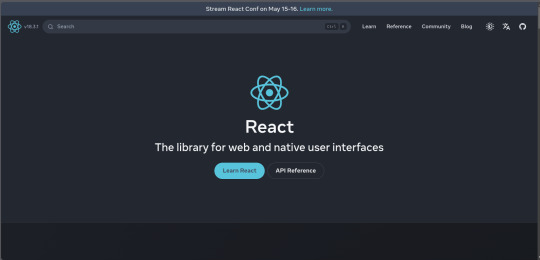
2. Angular
Angular, backed by Google, is a powerful framework for building dynamic single-page applications (SPAs).
Why Choose Angular?
Two-Way Data Binding: Synchronizes data between the model and the view.
Dependency Injection: Improves code maintainability and testability.
Comprehensive Documentation: Extensive resources for learning and troubleshooting.

3. Vue.js
Vue.js has gained popularity due to its gentle learning curve and versatility.
Advantages of Vue.js
Reactive Data Binding: Simplifies state management.
Single-File Components: Encapsulate HTML, CSS, and JavaScript in one file.
Flexibility: Can be used for both large-scale and small-scale applications.

4. Svelte
Svelte is a relatively new player that compiles components into highly efficient vanilla JavaScript at build time.
Svelte’s Standout Features
No Virtual DOM: Directly manipulates the DOM for better performance.
Less Boilerplate: Cleaner code with minimal overhead.
Ease of Use: Intuitive and straightforward syntax.
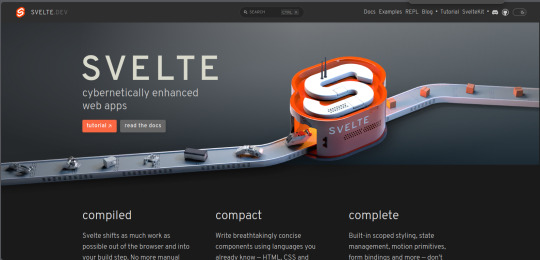
5. Bootstrap
Bootstrap is a front-end framework that provides pre-designed components and a responsive grid system.
Benefits of Using Bootstrap
Responsive Design: Ensures your site looks great on all devices.
Pre-Styled Components: Saves time with ready-to-use UI elements.
Customizable: Easily customize with Sass variables and Bootstrap’s extensive options.
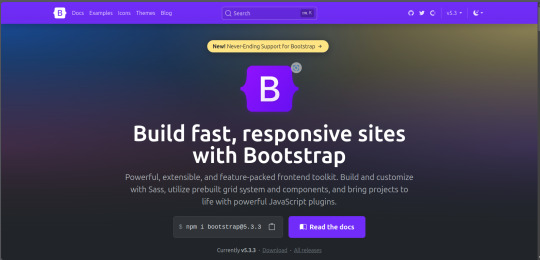
6. Tailwind CSS
Tailwind CSS is a utility-first CSS framework that allows for rapid UI development.
Tailwind CSS Features
Utility-First Approach: Use utility classes directly in your HTML.
Customizable: Extensive configuration options to suit your project’s needs.
Consistency: Enforces a consistent design language across your project.
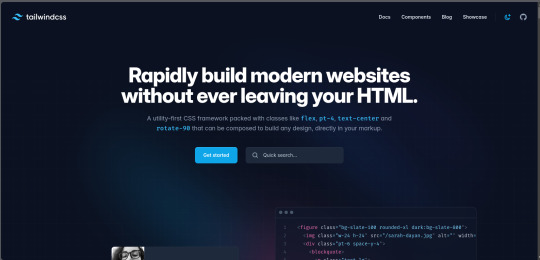
7. Ember.js
Ember.js is a robust framework for building ambitious web applications.
Why Ember.js Stands Out
Convention over Configuration: Reduces the amount of decision-making and boilerplate code.
Strong Routing: Powerful routing capabilities for managing application state.
Productivity: Focuses on developer productivity with built-in best practices.
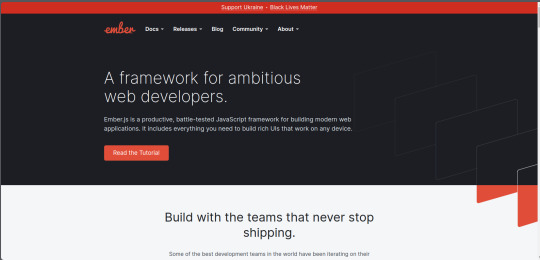
8. Alpine.js
Alpine.js offers a minimal and lightweight way to add interactivity to your websites.
Key Features of Alpine.js
Lightweight: Small footprint with only a few kilobytes.
Declarative Syntax: Similar to Vue.js, making it easy to understand and implement.
Ease of Integration: Can be easily integrated into existing projects.
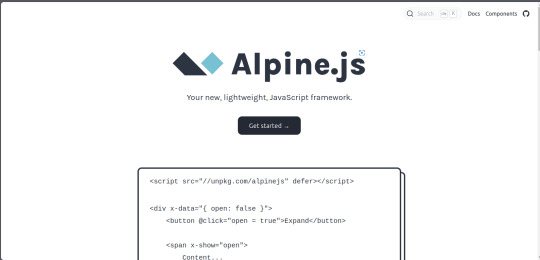
9. Next.js
Next.js is a popular React framework that enables server-side rendering and static site generation.
Benefits of Using Next.js
Server-Side Rendering (SSR): Improves performance and SEO by rendering pages on the server.
Static Site Generation (SSG): Pre-renders pages at build time for fast load times.
API Routes: Allows you to create API endpoints within your application.

10. Lit
Lit is a simple library for building fast, lightweight web components.
Advantages of Lit
Web Components: Embraces the web components standard for reusable, encapsulated HTML elements.
Performance: Lightweight and highly performant.
Simple API: Easy to learn and use with a minimal API surface.

Conclusion
Choosing the right front-end framework or library can significantly impact your workflow and the quality of your projects. Whether you prefer the flexibility of React, the structure of Angular, or the simplicity of Svelte, there's a tool out there to suit your needs.
Final Tips for Selecting a Framework or Library
Project Requirements: Consider the specific needs of your project.
Community and Support: Look for frameworks with strong community support and documentation.
Learning Curve: Choose a tool that matches your current skill level and the time you have available to learn.
By staying informed about the latest tools and trends, you can ensure that your skills remain relevant and that you can deliver the best possible results in your projects. Happy coding!
Remember, the best tool is the one that helps you get the job done efficiently and effectively. So, dive into these frameworks and libraries, and take your front-end development skills to the next level!
Share Your Thoughts
I'm curious to know your thoughts on these front-end frameworks and libraries. Have you used any of them in your projects? Which one is your favorite, and why? Share your experiences and insights in the comments below.👇
2 notes
·
View notes
Text
A reason why Full Stack Development is the future: Learn from GoDigiInfotech's experts in teaching
In today's hectic digital business world, organizations seek out experts who offer complete web-based solutions. This includes full stack development capability that allows developers to work with frontend and backend technologies that enable them to tackle the entire website-dependent project. This flexibility makes full-stack developers vital for companies in various sectors, especially in the technology areas in Pune and Kharadi. At GoDigiInfotech, our instructors help prepare the next generation of technologists to become the most sought-after in their field. In this blog, we'll go over the motives behind why full-stack development is the future trend. You'll gain insights directly from GoDigiInfotech's experienced instructors.
The Growing Demand for Versatile Developers
Full Stack Developers: The All-in-One Solution
Full-stack development is increasing in popularity because of the increasing demand for developers capable of doing everything capable of doing everything. In addition to the frontend interfaces that users use, backend databases, and everything in between, full-stack developers are sought-after because of their capability to simplify development processes and lessen the need for numerous experts. Since companies are increasingly looking for cost-effective solutions, having a single person who knows both aspects of web development is an advantage. Pune's Kharadi is well-known for its thriving IT business but desperately needs such experts.
Meeting the Needs of Modern Businesses
Pune, particularly technologically advanced areas like Kharadi companies, constantly evolve to keep ahead of the curve. With digital transformation becoming a top concern and a requirement, businesses aren't just creating websites. They're also developing full-time software that needs robust backend support and user-friendly and flexible frontends. Due to their vast knowledge of various technologies, full-stack developers can adapt to contemporary enterprises' constantly changing and complex demands. GoDigiInfotech's instructors emphasize that flexibility makes full-stack developers in demand and valuable shortly.
Mastering the Full Technology Stack
Frontend Expertise
The profession of a full stack designer requires thorough knowledge of frontend development, which entails developing appealing, responsive user interface Technologies like HTML, CSS, JavaScript, and the most recent frameworks like React as well as Angular, which are vital tools to create dynamic web pages that deliver the best quality of experience for users. At GoDigiInfotech, students learn these technologies through real-world projects, allowing them to know the methods used in web frontend development.
GoDigiInfotech's instructors stress the importance of understanding the user interface (UX) and user interface (UI) design. As the digital market grows more competitive, businesses require developers who can guarantee that their online applications are both functional and visually appealing.
Backend Proficiency
Full-stack developers aren't limited to the front end of the line. They also must be proficient in backend development, which consists of creating databases, servers, and the logic that drives their front end. The most well-known backend technologies include Node.js, Python, Ruby, PHP, and database management systems such as MySQL, PostgreSQL, and MongoDB. At GoDigiInfotech, our instructors teach students to think about how front and back interact frontend to develop scalable and efficient systems.
For businesses operating from Kharadi or Pune, backend development is crucial because web-based applications generally require massive data processing capabilities and handlers. Companies are seeking developers who can ensure that their apps function well under heavy load. Full-stack developers will be the best for the task.
DevOps and Cloud Computing
A key element in fully stacked development is knowledge of DevOps practices and cloud-based platforms such as AWS, Azure, and Google Cloud. As more companies shift to cloud-based infrastructures, developers understanding cloud computing are ahead of the pack. GoDigiInfotech's course includes DevOps fundamentals to help students manage development and maintenance applications in cloud-based environments.
Teachers at GoDigiInfotech frequently emphasize that cloud computing is no longer a luxury but a mandatory requirement. Full-stack developers with DevOps know-how can provide unhindered integration and continuous delivery, offering a complete solution for today's development needs.
Prospects for livelihood and versatility
Multiple Career Paths
The significant benefit of learning full-stack development is the wide range of jobs it can offer. If you're trying for a job as an engineer in software web development or starting your own tech business, the skills you acquire as a full-stack designer can be used. Pune, specifically within the Kharadi region, is home to an increasing tech industry that requires fully-stack engineers who can work across various sectors, including fintech, healthcare education, and online shopping.
GoDigiInfotech's knowledgeable instructors will explain how students who took their classes have been employed by top companies in India and around the globe. Through the vast training they offer, students will take on different positions within tech companies or even create a business that they can launch by themselves.
Remote Work and Freelancing open positions
Alongside the traditional work environment, Full-stack developers can be freelancers and remote programmers. The flexibility that comes with full-stack capabilities is unmatched. As businesses continue to prioritize digital transformation, remote complete stackers are sought-after. Companies are searching for developers who can handle entire projects from start to finish, even in another city or a foreign country.
Regarding residents of Pune and Kharadi, collaborating with clients from around the world allows them to broaden their networks and increase their potential income.
Ongoing Education: The Secret to Remaining Competitive
Keeping up on the most recent developments and fashions
The field of full-stack development is consistently developing and evolving. New frameworks, libraries, and tools are continuously released, meaning developers must remain committed to continuous learning. At GoDigiInfotech, our instructors stress the importance of keeping current on the latest developments in the field and technologies. From learning about the most recent JavaScript library to understanding the most current cloud platforms, up-to-date full-stack developers are always in demand.
Hands-On Learning at GoDigiInfotech
What makes GoDigiInfotech distinct from other institutions is our commitment to hands-on learning. This full-stack development training program was created to allow students to experience hands-on, real-world projects and industry examples. Our highly knowledgeable trainers guide learners through each step of the development method, ensuring they graduate with confidence and the skills needed to succeed in their field.
This emphasis on the practical side of learning ensures that students are learning more than just the basics as they gain the experience they need to meet the requirements of this world. Suppose you are a programmer who wants to be part of the next generation and is looking to build within Pune and Kharadi. In that case, GoDigiInfotech provides the perfect platform for you to start an exciting career in full-stack development.
Conclusion
Web development is, without doubt, full stack. Proficient professionals who know both back and front-end technologies will be at the top of the line for job opportunities. There are endless opportunities for tech-savvy people who reside mainly in Pune, especially in Kharadi. At GoDigiInfotech, our expert instructors are dedicated to helping students develop the skills required to excel in the ever-changing world. If you're trying to launch your job ma, leap into the technology field, or increase your abilities to be a full stack developer. Development could be the best chance to succeed in the future.
If you take part in GoDigiInfotech's full-stack development course, it's more than learning the fundamentals of a trade. You're creating an unstoppable job.
1 note
·
View note
Text
Top Frontend Frameworks for Web Development in 2024

In 2024, web development will still be thriving, and frontend frameworks will be essential to producing dynamic, responsive, and user-friendly applications. The best frontend frameworks for 2024 will be discussed in this blog, together with their salient characteristics, advantages, and reasons for being necessary for contemporary online development. We'll also go over the benefits of collaborating with an Angular development business and employing Angular developers in India.
1. Angular 18:
Angular's front-end the power is carried over with Angular 18, which is developed and maintained by Google. It provides a whole solution for developing and growing single-page applications using best practices as a comprehensive framework.
Why is Angular 18 used?
Angular 18's robust performance, manageability, and wide ecosystem make it perfect for large-scale enterprise apps. It is an excellent option for developers due to its strong community support and sophisticated tooling.
Hire Angular Developers in India:
Hiring Angular developers in India provides access to a vast pool of knowledgeable experts that can construct and scale intricate web apps at a reasonable cost. From design and development to deployment and maintenance, Indian Angular development businesses offer full-service solutions.
2. React:
React, a front-end framework created by Facebook, is still the best in 2024. It is a favourite among developers because of its flexibility and simplicity as well as its strong development tools. Its large population and diverse ecosystem serve to further increase its efficacy and appeal.
Why Make Use of React?
React is appropriate for both small and large apps because of its adaptability and user-friendliness. It is an excellent option for developers due to its large community and thousands of libraries.
Employing React Developers:
Skilled React developers guarantee dependable solutions, optimal procedures, and enhanced project outcomes. A wide selection of React development services are available from numerous organizations' in India, making it possible to plan web development strategically and affordably.
In conclusion
there are many strong front-end frameworks available in 2024, including as Next.js, Angular 18, React, Vue.js, and Svelte. For different web development requirements, ranging from enterprise applications to high-performance sites, each has special advantages.
Hiring specialized experts from Tuvoc Technologies is a wise decision if you're looking for web development that is scalable and effective. We offer competent Angular and other framework developers at reasonable prices, guaranteeing successful and economical solutions.
Source URL: https://www.tuvoc.com/blog/top-frontend-frameworks-for-web-development-in-2024/
#FrontendFrameworks#WebDevelopment2024#Angular18#ReactJS#VueJS#Svelte#NextJS#TechTrends2024#WebDevTrends#ModernWebDevelopment
0 notes
Text
Transform Your IT Career with Premier Training Institutes in Chembur
In the bustling and ever-evolving world of information technology, staying ahead of the curve is crucial. For professionals and aspiring IT enthusiasts in Mumbai, Chembur is home to several esteemed IT training institutes that offer top-notch education and hands-on experience. Whether you're looking to sharpen your skills, switch careers, or start from scratch, Chembur’s IT training centers provide a variety of courses tailored to meet diverse needs.
One of the most significant advantages of IT training institute in Chembur is their strategic location. Chembur is a well-connected locality, making it accessible for individuals from various parts of Mumbai. The area’s infrastructure supports easy commutes, ensuring that students can attend classes without significant travel hassles.
Top Training Programs Offered
Software Development: Many institutes in Chembur offer comprehensive courses in software development, including programming languages like Java, Python, and C++. These courses are designed to provide a solid foundation in coding and software engineering principles. Students learn to build and manage software applications, a skill set that is highly valued in today’s job market.
Web Development: With the increasing demand for web developers, institutes in Chembur provide specialized training in front-end and back-end web development. Courses cover HTML, CSS, JavaScript, and various frameworks such as React and Angular. These programs often include real-world projects, giving students practical experience in building and maintaining websites.
Data Science and Analytics: As data continues to play a pivotal role in decision-making across industries, data science courses have become highly popular. Institutes in Chembur offer training in data analysis, machine learning, and data visualization using tools like Python, R, and SQL. These programs equip students with the skills needed to analyze complex data sets and derive actionable insights.
Cybersecurity: With increasing concerns over data breaches and cyber threats, cybersecurity training is essential. Chembur’s institutes offer courses on network security, ethical hacking, and information security management. These programs aim to prepare students to protect digital assets and understand various security protocols and strategies.
Networking: For those interested in the infrastructure side of IT, networking courses are available. These programs cover networking fundamentals, network design, and troubleshooting. Certifications such as Cisco's CCNA are often part of the curriculum, helping students to qualify for various networking roles.
Why Choose Training Institutes in Chembur?
Quality Education: Institutes in Chembur are known for their high standards of education. Many of these centers have experienced trainers who bring industry knowledge and practical insights into the classroom. This quality instruction ensures that students receive relevant and up-to-date knowledge.
State-of-the-Art Facilities: Many Online IT courses Chembur are equipped with modern labs and facilities. This hands-on approach helps students gain practical experience, which is crucial for understanding theoretical concepts.
Career Support: Beyond teaching, many institutes offer career services such as resume building, interview preparation, and job placement assistance. These services can significantly enhance a student’s employability and career prospects.
Flexible Learning Options: Understanding the diverse needs of students, institutes offer flexible learning options, including weekend batches, evening classes, and online courses. This flexibility allows individuals to balance their studies with other commitments.
For anyone looking to advance their career or break into the IT industry, Chembur’s IT training institutes offer a wealth of opportunities. With a range of programs designed to cater to various interests and skill levels, students can find the perfect course to meet their career goals. By choosing a reputable institute in Chembur, individuals can invest in their future and gain the skills needed to thrive in the competitive world of IT.
0 notes
Text
Top Tools and Frameworks for Custom Software
In the world of tech, custom software is on the rise. Every business, big or small, wants software that’s made for them. But here’s the thing custom software isn’t just about writing code. It’s about choosing the right tools and frameworks that match your project goals, scale and performance. The tools you choose can make or break your project, from development speed to end user experience.
So whether you’re a developer, project manager or business owner looking to get the most out of your custom software development, knowing the top tools and frameworks out there is key. In this post we’ll look at some of the most popular and powerful ones that can help you bring your software to life.
1. React.js
React.js is the go to framework for front-end development. Built by Facebook, this JavaScript library lets you build dynamic and interactive UI’s with ease. Its component based architecture makes it perfect for large scale applications where consistency and performance is key.
2. Angular
Angular, maintained by Google, is another big player in front-end development. Unlike React, Angular is a full framework that comes with everything you need to build robust applications, from data binding to dependency injection. Its strong community support and regular updates means your application will always be modern and efficient.
3. Django
For back-end development, Django is a framework that’s hard to ignore. Written in Python, Django helps developers build secure and scalable web applications fast. Its “batteries-included” philosophy means it comes with loads of built-in features like authentication, ORM (Object-Relational Mapping) and more, so you don’t need to hunt for third party libraries.
4. Node.js
Node.js is a runtime environment that lets you run JavaScript on the server side. It’s popular for building scalable network applications thanks to its non-blocking, event driven architecture. Node.js is perfect for real-time applications like chat apps or online gaming where performance and speed is key.
5. Spring Boot
Spring Boot makes developing Java applications easier, especially when it comes to microservices. With its convention-over-configuration approach, Spring Boot reduces the amount of boilerplate code, so you can focus on the business logic of the app. It also plays nicely with other Spring components so it’s a great choice for enterprise apps.
6. Flutter
For mobile apps, Flutter is becoming a popular framework that lets you build natively compiled apps for mobile, web and desktop from a single codebase. Built by Google, Flutter’s UI approach using widgets lets you build fast and beautiful apps.
7. Docker
Not a framework, but a must have tool in modern software development. Docker lets you package your application into containers so the application will run the same way on your developer’s laptop as it will in production, so no more “it works on my machine” problem.
8. Kubernetes
As your software applications get more complex, managing them in production gets harder. This is where Kubernetes comes in. Kubernetes is an open source platform to automate deploying, scaling and operating application containers. It’s particularly useful for microservices architecture to ensure your application is resilient and scalable under different loads.
Summary
The world of custom software development is full of tools and frameworks, each with its own advantages. Choose the ones that fit your project’s needs. By using these tools you can speed up your development, improve your software and deliver what your business needs. Whether you want to build a front-end, back-end or high performance mobile app, there’s a tool or framework for that.
0 notes
Text
Pros of Vue.js
Before we proceed further, let's know the advantages of using Vue.js over other Frameworks and Technologies for Front-end Development.
Here is a list of the Pros of operating with Vue.js!
Effortless Integration
Developers can integrate Vue.js with other Frameworks effortlessly.
Some frameworks developers usually integrate with Vue.js are React and Angular.
Moreover, Developers use JavaScript for back-end Development.
Better learning process
Freshers find Vue.js simple to learn and experiment with.
If the Developer understands HTML, CSS, and JavaScript, their learning curve will be better.
Two-Way Binding
You know that React has One-Way Binding. However, Vue is Two-Way Binding like Angular.
Tracking updates and data handling is better with Vue.js. Therefore, you can effortlessly deal with real-time Web Applications and updates.
Know more -
0 notes
Text
The Future of Frontend Development: Trends and Predictions for the Next Decade
As technology advances, the field of frontend development is rapidly evolving. From new tools and frameworks to innovative design approaches, the future of frontend development is set to bring exciting changes. In this blog, we'll explore the key trends and predictions that are expected to shape the next decade of frontend development.

1. The Rise of WebAssembly (Wasm)
One of the most groundbreaking developments in frontend development is the rise of WebAssembly (Wasm). WebAssembly is a binary instruction format designed to execute code at near-native speed in web browsers. This technology allows developers to use languages like C, C++, and Rust to build web applications, breaking free from the traditional reliance on JavaScript.
What This Means for the Future:
Performance Boost: WebAssembly enables high-performance web applications that were previously difficult to achieve with JavaScript alone. This opens the door for more complex applications, such as 3D graphics, video editing, and games, to run smoothly in the browser.
Broader Language Support: As more languages are compiled into WebAssembly, developers will have greater flexibility in choosing the best tools for their projects, potentially leading to more diverse and innovative web applications.
2. Continued Dominance of JavaScript Frameworks
JavaScript frameworks like React, Vue.js, and Angular have become staples in frontend development, and their influence is only expected to grow in the coming years. These frameworks provide the building blocks for creating interactive and dynamic web applications, making them essential tools for modern developers.
What This Means for the Future:
Ecosystem Expansion: The ecosystems around these frameworks will continue to grow, with more libraries, tools, and plugins being developed to enhance their functionality.
Improved Developer Experience: Frameworks will focus on improving developer experience, with better tooling, more efficient state management, and enhanced debugging capabilities.
Increased Adoption of Component-Based Architecture: Component-based development, popularized by these frameworks, will become the standard approach, promoting reusability and maintainability of code.
3. Progressive Web Apps (PWAs) Becoming the Norm
Progressive Web Apps (PWAs) are web applications that offer a native app-like experience. They can work offline, send push notifications, and be installed on a user’s device, blurring the line between web and native apps. As users demand faster and more reliable experiences, PWAs are expected to become more prevalent.
What This Means for the Future:
Wider Adoption by Businesses: More businesses will invest in PWAs as a cost-effective alternative to native apps, especially for reaching a broader audience without the need for platform-specific development.
Enhanced Capabilities: Advances in browser APIs will allow PWAs to access more native features, further closing the gap between web apps and native apps.
SEO Benefits: PWAs, being indexable by search engines, will continue to offer advantages in SEO over traditional native apps, making them an attractive option for content-driven businesses.
4. The Growth of Jamstack Architecture
Jamstack (JavaScript, APIs, and Markup) is an architecture designed to make the web faster, more secure, and easier to scale. By decoupling the frontend from the backend and leveraging static site generation, Jamstack offers a modern approach to building websites and apps.
What This Means for the Future:
Faster Websites: Jamstack sites are pre-rendered and served as static files, resulting in lightning-fast load times and improved performance.
Scalability and Security: Since Jamstack sites rely heavily on CDNs and APIs, they are easier to scale and inherently more secure, reducing the risk of server-side vulnerabilities.
Increased Adoption by Enterprises: As enterprises seek to improve site performance and user experience, Jamstack will see increased adoption, especially for content-heavy sites and e-commerce platforms.
5. AI and Machine Learning Integration
The integration of AI and machine learning into frontend development is set to revolutionize the way web applications are built and how users interact with them. From personalized user experiences to intelligent automation, AI will play a significant role in the future of frontend development.
What This Means for the Future:
Personalized User Experiences: AI will enable more personalized user experiences by analyzing user behavior and adapting content and interface elements in real-time.
Enhanced Design Automation: AI-driven tools will assist in design tasks, such as generating layouts, optimizing UI components, and even writing code, reducing the time and effort required for development.
Improved Accessibility: AI can help make web applications more accessible by automatically generating alt text, captions, and other assistive features, ensuring a more inclusive web experience.
6. The Evolution of CSS and Design Systems
CSS has been a fundamental part of frontend development, and it continues to evolve. With the introduction of new features like CSS Grid, Flexbox, and custom properties (CSS variables), developers have more power than ever to create sophisticated layouts and designs.
What This Means for the Future:
Advanced Layout Capabilities: The continued evolution of CSS will enable more complex and responsive layouts, making it easier to create visually stunning web applications.
Design Systems and Component Libraries: The use of design systems and component libraries will become more prevalent, promoting consistency across large-scale projects and improving collaboration between designers and developers.
CSS-in-JS: The trend of writing CSS within JavaScript (CSS-in-JS) will continue to gain traction, particularly in React and other component-based frameworks, offering better performance and more dynamic styling options.
7. The Shift Toward No-Code and Low-Code Development
The rise of no-code and low-code platforms is democratizing web development by allowing non-developers to build websites and applications with minimal coding knowledge. These platforms offer drag-and-drop interfaces and pre-built components, making web development more accessible.
What This Means for the Future:
Empowering Non-Developers: As no-code and low-code platforms mature, more businesses will be able to create and manage their own web applications, reducing reliance on development teams for simpler projects.
Accelerated Development Cycles: Even professional developers will leverage these platforms to speed up development cycles, allowing them to focus on more complex and custom features.
New Challenges for Frontend Developers: While these platforms simplify certain aspects of development, frontend developers will need to adapt by focusing on more specialized and advanced areas where custom coding is still required.
8. The Importance of Web Performance and Core Web Vitals
Web performance has always been a critical factor in frontend development, but with the introduction of Core Web Vitals by Google, it has become even more crucial. Core Web Vitals are a set of metrics that assess the user experience on a website, including loading performance, interactivity, and visual stability.
What This Means for the Future:
Performance-Driven Development: Frontend developers will increasingly prioritize performance optimization, as it directly impacts SEO rankings and user retention.
Tools and Frameworks Adaptation: Tools and frameworks will continue to evolve to help developers optimize for Core Web Vitals, offering built-in features for measuring and improving performance.
Greater Focus on User-Centric Metrics: As web performance becomes a more significant factor in determining a website’s success, developers will need to pay close attention to user-centric metrics and ensure their sites meet the highest standards.
Conclusion
The future of frontend development is set to be dynamic and full of innovation. From the rise of WebAssembly and Progressive Web Apps to the growing importance of AI and machine learning, the next decade will bring significant changes to how websites and applications are built. By staying informed about these trends and embracing new technologies, frontend developers and businesses can ensure their digital products remain competitive, user-friendly, and ahead of the curve.
1 note
·
View note
Text
Cloud App Development and work with Advantage
What is Cloud App Development?
Some of the vital elements of cloud app development would be only the writing of applications that are going to be hosted on the cloud. Cloud applications are rendered with the help of cloud computing resources to deliver services over the internet. That is, they bring a level of flexibility, scalability, and accessibility that traditional applications, which are deployed on local servers or personal devices, cannot offer.
Cloud apps can be accessed via the internet from anywhere on the globe. Thus, they work very well in the contexts of business and individual requirements for remote work or collaboration in different locations. The building involves mainly cloud services—like storage, databases, and computing power that are available on cloud platforms such as AWS, Google Cloud, or Microsoft Azure. These are platforms that provide influences to a set of tools and services that cater to both the early stages of the cloud app development process (coding and testing) as well as the stages of deployment and monitoring.
Developers are given the ability to choose the most suitable architectural solution of optimization that suits their needs for the optimization of performance and resource management. It all depends on securing the cloud app development by the one-time secure user authentication, data encryption and timely updates. The cloud enables developers to build applications that are efficient, scalable, and can be easily adapted to necessary requirements of users and businesses.
How to Code a Cloud App?
The whole process of coding of cloud app covers lots of steps and considerations, primarily the aspect of the scalability, reliability, and security of an application. First and foremost, it is essential to identify the correct cloud platform that would have the best services for the project, such as one of the following: AWS, Google Cloud, or Microsoft Azure. Each of the platforms we discussed before has a wide range of tools and services specifically designed to meet the needs of the cloud application development field.
First, concentrate on your development infrastructure and install the necessary SDKs, configure the APIs, or use cloud services such as databases, storage, or compute instances.
First of all, draw the structure of your app so that it is realistic. You can either go for the single microservices architecture, where one microservice reads and consumes the data, while the other microservice produces and provides the data, and serverless architecture is expressed as the serverless functions that execute the app code without constructor and managing others which are the basic for choosing the cloud platform. Based on the specific needs of your application, each of the variants is presented in these two options.
Start your project in an appropriate technology for that. For example, technologies that are well-liked are Java, Python, Node.js, and Go.The while on your end you may come across React, Angular, or Vue.js.Integrate cloud services at the early design stage. Managed databases such as Amazon RDS or Google Cloud SQL are responsible for providing data storage. On the other hand, cloud storage services are used.
Invent your application in such a way it integrates likeable authentication and authorization mechanisms that are also strong to implement the security features in your app. To achieve this, you will have to use services like AWS IAM and Google Cloud Identity to control users' access and permissions. After certain periods of time, you should always check your application in the cloud environment to see if there are any issues that you may solve before they become more major ones. Utilize automated testing tools and CI/CD pipelines that run on themselves to speed up the process if possible.
Consequently, maintain the system with cloud services automated monitoring and logging. The tools like AWS CloudWatch, Google Stackdriver, and Azure Monitor let's get a good level monitoring through the data of the underlying physical OS's performance that help to run the application more reliable and efficiently.
How does a cloud app work?
Initially, the cloud application is based on using the cloud computing technology for the resources and services that are offered on the cloud computing platforms. A cloud application is defined as an application that is created in the cloud, where all its processing and storage happen and the user is only allowed access via the internet and efficient operation is through a hardware device with high local power.
Calls from the cloud provider's data center to the user are made on the internet once a user starts using a cloud app. In truth, at this stage, such requests are handled by the app backend running on the computational resources of the cloud. For example, when a user uploads a file, the app will send the data to cloud storage services such as Amazon S3 or Google Cloud Storage. Furthermore, if the application requires some high-level computations, it may use cloud computing services that are located somewhere in the cloud.
Each app's architecture is unique and depends on its complexity and the goals it should achieve. One of the most common types of cloud applications is microservice architecture. In fact, the application is usually divided into several smaller, independent services, which communicate with each other through APIs, which are the actual operational blocks of the application, so they become modular, scalable, and also easy to manage. One common architecture is serverless, where a function runs as a reaction to a specific event i.e. HTTP request that can be handled without the need for servers' management.
Security is a core part of the way cloud apps are developed. In some situations, the data is encrypted both in the transmission and at rest just to secure it against unauthorized access. The cloud providers also give some of the security tools and services that may be used during the development process in order to generate the best practices, compliance,
Alternatively, the idea of working with a cloud app can be viewed as spreading the functions in the cloud infrastructures of the service provider, via systems that are scalable, elastic, and also accessible that can be rapidly deployed as well as updated.
What are the Advantages of Cloud Apps?
Cloud apps are the latest solutions that have been quickly preferred by any business or developer since they bring a lot of benefits. Scalability often listed as one of the major upsides of cloud apps. They offer the possibility of easily scaling up or down depending on the demand, ensuring the highest use of resources without over-provisioning them. This elasticity is excellent for companies with shifting work- loads or those expanding at a rapid pace.
Cost-effectiveness is another major upside. As for cloud apps, businesses pay only for what they use, thereby slashing the capital expenditure needed to maintain physical servers and infrastructure. The pricing approach of cloud providers is varied with consumers getting the ones that match their interests best.
Cloud apps also provide the advantage of accessibility. People can connect to cloud applications from the various gadgets or devices they own as long as they are online, which enables the solution of remote working and collaboration at any time and place that one wants—attributes that are not only extremely critical in today's connected and omnipresent work-life but also brought about by the globalization and increased mobility of the society.
Not only this but cloud-based applications also add to the approving the disaster recovery and business continuity. Cloud providers propose to businesses an all-inclusive backup and recovery plan, which includes ensuring the data safety and rapid restoration in the case of an outage or disaster. This has the advantage that it reduces the time required for such operations and makes the data more secure.
One other very interesting aspect of cloud deployments is security. Cloud providers including major players are massively committed to protecting their customers through such measures as encrypting the data, maintaining proper access controls, and providing security updates. Besides, they comply with the industry norms and regulations to ensure the business is hosting the applications and data in a safe environment.
Hence, having access to cloud platforms comes with the freebies of innovation. Cloud providers come up with new services and features on a regular basis and it is through using these that developers are able to attain new technology and use tools to enhance their applications. By so doing, this will allow the companies to sail through the market forcing the development of the applications and thereby; they are put in a better position.
Ultimately, cloud apps can be a solution to the major requirements that modern application development presents such as; flexibility and scalability, cost-effectiveness, mobility, and security improvement. Through this, cloud platform users consequently tend to add business continuum, recovery, and constant innovation to their offer.
0 notes
Text
Top 5 Front-End Frameworks for Building Modern Web Applications
In today's fast-paced digital world, building modern web applications requires efficient, robust, and user-friendly front-end frameworks. These frameworks simplify the development process, enhance performance, and ensure a seamless user experience. Here, we explore the top 5 front-end frameworks that are most searched by developers and tech enthusiasts.

1. React: The King of Modern Web Development
React is a widely popular JavaScript library developed by Facebook. Known for its component-based architecture, React allows developers to build reusable UI components, making code maintenance and scalability easier. With React's virtual DOM, updates are fast and efficient, ensuring a smooth user experience. Key features include JSX syntax, state management with hooks, and integration with various tools and libraries.
2. Angular: A Comprehensive Framework by Google
Angular is a powerful, full-featured framework maintained by Google. It uses TypeScript, a superset of JavaScript, providing strong typing and improved tooling. Angular's two-way data binding and dependency injection simplify development and testing. Its extensive documentation and robust ecosystem make it a go-to choice for building large-scale enterprise applications.
3. Vue.js: The Progressive JavaScript Framework
Vue.js has gained immense popularity due to its simplicity and flexibility. It is designed to be incrementally adoptable, meaning you can use as much or as little of the framework as needed. Vue.js features a reactive data binding system and a component-based architecture similar to React. Its ease of integration with existing projects and a gentle learning curve make it an excellent choice for both beginners and experienced developers.
4. Svelte: The Radical New Approach
Svelte is a relatively new front-end framework that takes a radical approach by shifting much of the work to compile time. Unlike traditional frameworks that do most of their work in the browser, Svelte compiles your code to efficient, imperative JavaScript that updates the DOM surgically. This results in faster performance and smaller bundle sizes. Svelte's simplicity and lack of boilerplate code make it an attractive option for developers seeking a streamlined development process.
5. Ember.js: The Framework for Ambitious Web Applications
Ember.js is a robust, opinionated framework designed for building ambitious web applications. It offers a convention-over-configuration philosophy, which means it has a lot of built-in functionality that allows developers to follow best practices without much configuration. Ember.js includes a powerful CLI, a templating engine called Handlebars, and a comprehensive data layer with Ember Data. Its strong community and adherence to stability make it a reliable choice for large projects.
Conclusion
Choosing the right front-end framework for your web application can significantly impact your development process and the end-user experience. React, Angular, Vue.js, Svelte, and Ember.js each offer unique features and advantages tailored to different project needs and developer preferences. By leveraging these modern frameworks, you can build efficient, scalable, and user-friendly web applications that stand out in today's competitive digital landscape.
#wishlan#it company#startup#it services#web design agency#digital marketing#it solutions#web development
0 notes
Text
The Future of JavaScript Frameworks: What's Next?
JavaScript frameworks have evolved significantly over the years, shaping the way developers build web applications. As we look to the future, several trends and advancements promise to further revolutionize this landscape.

Current Trends and Emerging Frameworks
The popularity of frameworks like React, Angular, Vue, and Svelte continues to grow, each offering unique advantages. New contenders, such as Solid and Qwik, are emerging, promising improved performance and developer experience.
Component-Based Architecture and SSR
The shift towards component-based design enhances modularity and reusability, making development more efficient. Additionally, server-side rendering (SSR) and static site generation (SSG) are gaining traction for their performance benefits and improved SEO, with tools like Next.js and Nuxt.js leading the way.
Integration with Modern Technologies
JavaScript frameworks are increasingly integrating with TypeScript for type safety, and backend technologies
like GraphQL and REST APIs. This trend enhances the robustness and scalability of applications.
Micro-Frontends and WebAssembly
Micro-frontends are becoming popular, allowing teams to develop and deploy features independently. Meanwhile, WebAssembly (Wasm) offers significant performance benefits, potentially transforming the way we build web applications.
Enhanced Tooling and AI Integration
Improvements in developer tools, better debugging, and testing frameworks are making development more seamless. The integration of AI and machine learning into JavaScript frameworks is also on the horizon, promising smarter and more interactive applications.
Progressive Web Apps (PWAs) and State Management
PWAs remain relevant, with frameworks and tools continuously improving. State management solutions are evolving, with libraries like Redux and MobX being complemented by newer patterns and practices.
Community Growth and Security
The open-source community plays a crucial role in the growth of JavaScript frameworks. Ensuring security in these frameworks is paramount, with best practices continually evolving to address new challenges.
As we move forward, the future of JavaScript frameworks looks promising, with continuous innovation and improvements. Plassey Technologies is one of the Top 10 Website Development Agency in Gurgaon, keeping pace with these advancements to deliver cutting-edge solutions. The journey ahead is exciting, with endless possibilities for developers and businesses alike.
Conclusion
The landscape of JavaScript frameworks is dynamic and ever-evolving. By embracing new trends and technologies, developers can create more efficient, secure, and powerful web applications. The future holds immense potential, and staying updated with these trends is crucial for anyone involved in web development.
0 notes
Text

Certainly! Here’s a long description using the keyword "Java or JavaScript":
Choosing the Right Language: Java or JavaScript?
When it comes to programming languages, the debate often narrows down to Java or JavaScript. Both are widely used, yet they serve different purposes and are suited to distinct types of development projects. Understanding the differences and strengths of each can help you determine which is the best fit for your needs.
Java is a high-level, object-oriented programming language that was introduced by Sun Microsystems in 1995. Known for its "write once, run anywhere" capability, Java is platform-independent, making it an excellent choice for cross-platform applications. It's predominantly used for building large-scale enterprise applications, Android applications, server-side applications, and complex systems that require high security and performance. Java's robustness, security features, and extensive libraries make it a favorite among developers for backend development and large enterprise solutions.
JavaScript, on the other hand, is the language of the web. Initially developed by Netscape in 1995, JavaScript is a high-level, interpreted scripting language primarily used for enhancing the interactivity and functionality of websites. It runs directly in web browsers, making it the go-to language for front-end development. JavaScript enables dynamic content, allowing developers to create interactive elements such as forms, animations, and real-time updates. With the advent of Node.js, JavaScript has expanded to server-side development, making it a full-stack language. Its versatility is further enhanced by frameworks like React, Angular, and Vue.js, which streamline the development of complex web applications.
When deciding between Java or JavaScript, consider the specific requirements of your project. If you're working on a project that demands robust backend processing, high security, and scalability, Java is likely the better choice. It is well-suited for applications that require significant processing power and handle large amounts of data, such as banking systems, enterprise software, and mobile applications for Android.
In contrast, if your project involves creating dynamic and responsive web interfaces, JavaScript is essential. Its ability to manipulate the DOM (Document Object Model) in real-time makes it ideal for applications that need a high level of user interaction. JavaScript's frameworks and libraries provide tools to efficiently manage and develop complex client-side applications, enhancing the user experience with seamless navigation and real-time updates.
Both Java and JavaScript are integral to modern software development, each excelling in different domains. The decision to use Java or JavaScript should be based on the nature of your project, the development environment, and your specific goals. Whether you need the robust capabilities of Java for backend systems or the dynamic flexibility of JavaScript for interactive web pages, understanding the strengths of each language will guide you in choosing the right tool for your development needs.
This description emphasizes the distinct roles and advantages of Java and JavaScript, helping users understand when to choose one over the other based on their project requirements.
0 notes
Text
s Web Development Dying?

Web development over the years has seen tremendous growth and transformation, since its inception. With the rise of new technologies, including DIY website builders and artificial intelligence (AI), there is speculation about the future of traditional web development. Is web development dying? Let us explore the evolving landscape of web development, the role of DIY and AI tools, and why skilled web developers are still crucial.
The Evolution of Web Development
Web development has continuously evolved as driven by advancements in technology and changing user expectations. Initially, web development was a highly specialized field requiring in-depth knowledge of HTML, CSS, and JavaScript. Over the years, the introduction of various frameworks and libraries such as React, Angular, and Vue.js has streamlined the development process, making it more accessible.
However, the landscape is changing further with the emergence of DIY website builders and AI-powered tools. These innovations promise to democratize web development, allowing individuals with little to no coding knowledge to create websites.
The Role of DIY in Web Development
DIY website builders like Wix, Squarespace, and WordPress have revolutionized web development. These platforms provide drag-and-drop interfaces, pre-designed templates, and a range of plugins, enabling users to create websites quickly and easily.
Advantages of DIY Tools:
Accessibility: DIY tools make web development accessible to non-developers, allowing small business owners, bloggers, and hobbyists to create their own websites without needing extensive coding knowledge.
Cost-Effective: Building a website using a DIY tool is often cheaper than hiring a professional developer, making it an attractive option for startups and small businesses.
Speed: DIY platforms enable rapid website creation, which is beneficial for those needing a quick online presence.
Limitations of DIY Tools:
Customization: While DIY tools offer a range of templates and plugins, they often lack the deep customization capabilities that a professional developer can provide.
Scalability: As a business grows, the limitations of a DIY website may become apparent, necessitating a more robust, custom-built solution.
SEO and Performance: DIY websites may not always be optimized for search engines or performance, which can impact visibility and user experience.
The Role of AI in Web Development
Artificial intelligence is another game-changer in the field of web development. AI-powered tools can automate various aspects of the development process, from design to coding and maintenance.
Applications of AI in Web Development:
Automated Coding: AI-driven code generators can produce code snippets or entire web pages based on user inputs. Tools like GitHub Copilot use machine learning to assist developers by suggesting code as they type.
Design Assistance: AI can analyze design preferences and user behavior to suggest layouts, color schemes, and other design elements. Platforms like Adobe Sensei leverage AI to enhance design capabilities.
Chatbots and Virtual Assistants: AI-driven chatbots can be integrated into websites to provide real-time customer support, improving user engagement and satisfaction.
Impact of AI on Web Development:
Efficiency: AI can significantly speed up the development process by automating repetitive tasks and reducing the potential for human error.
Skill Shift: Developers are now required to have knowledge of AI and machine learning concepts to fully utilize these tools, leading to a shift in the skill set required for modern web development.
The Continued Need for Skilled Web Developers
Market Demand: The global web development market is expected to reach USD 89013.17 million by 2027. The web development market is expected to exhibit a CAGR of 8.03% by 2027. (Fortune Business Insights).
E-commerce Growth: The rise in e-commerce, especially accelerated by the COVID-19 pandemic, has increased the demand for web developers to create and maintain online stores. According to Statista report, In 2023, global retail e-commerce sales reached an estimated 5.8 trillion U.S. dollars. Projections indicate a 39 percent growth in this figure over the coming years, with expectations to surpass eight trillion dollars by 2027.
The growing web development market and e-commerce growth hence increases job opportunities for web developers. Despite the rise of DIY tools and AI, the demand for skilled web developers remains robust. According to the U.S. Bureau of Labor Statistics, employment of web developers and digital designers is projected to grow 8% from 2019 to 2029, much faster than the average for all occupations.
Reasons for the Ongoing Demand:
Complex Projects: Businesses often require complex, custom-built web solutions that DIY tools and AI cannot fully deliver. Professional developers are needed to create and maintain these sophisticated websites and applications.
Integration: Modern web applications often need to integrate with other systems and platforms, requiring a deep understanding of APIs, databases, and server-side technologies that DIY tools cannot provide.
Performance and Security: Ensuring optimal performance and robust security for websites and applications is a critical task that requires specialized knowledge and expertise.
Skills Required for Modern Web Developers
The evolving web development landscape requires developers to adapt and acquire new skills. Proficiency in traditional programming languages like HTML, CSS, JavaScript, Python, and frameworks such as React and Node.js remains essential. Additionally, skills in cloud computing, AI, machine learning, and cybersecurity are becoming increasingly valuable.
Soft skills are also crucial. Problem-solving, communication, and teamwork are highly valued as they enable developers to work effectively within diverse teams and complex projects. Remote work, which remains prevalent, further underscores the need for strong communication skills.
Conclusion
Web development is far from dying; it is evolving with the advent of DIY tools and AI technologies. These innovations are reshaping the landscape, making web development more accessible and efficient. However, they do not eliminate the need for skilled web developers. The complexity, customization, and advanced functionalities required by many modern websites and applications ensure that professional developers remain indispensable.
The future of web development lies in the synergy between traditional skills and new technologies. Developers who adapt to the changing landscape by embracing AI and continuously updating their skill sets will be well-positioned to thrive in this dynamic field. Thus, while the tools and methods may change, the fundamental need for web development expertise will persist, driving innovation and growth in the digital age.
0 notes